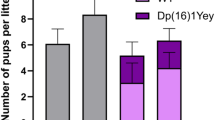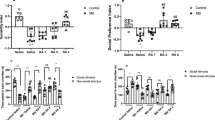Abstract
Infectious diseases in early postnatal ontogenesis can induce neuroinflammation, disrupt normal central nervous system development, and contribute to pathogenesis of cerebral pathologies in adults. To study long-term consequences of such early stress, we induced neonatal proinflammatory stress (NPS) by injecting bacterial lipopolysaccharide into rat pups on postnatal days 3 and 5 and then assessed the levels of corticosterone, proinflammatory cytokines and their mRNAs, and neurotrophins and their mRNAs in the hippocampus and neocortex of the one-month-old animals. Long-term potentiation (LTP) was studied in hippocampal slices as an index of synaptic plasticity. NPS-induced impairments of LTP were accompanied by the accumulation of corticosterone and IL-6 in the hippocampus. In the neocortex, a decrease in exon IV BDNF mRNA was detected. We suggest that excessive corticosterone delivery to hippocampal receptors and proinflammatory changes persisting during brain maturation are among the principal molecular mechanisms responsible for NPSinduced neuroplasticity impairments.
Similar content being viewed by others
Abbreviations
- BDNF:
-
brain-derived neurotrophic factor
- CNS:
-
central nervous system
- CS:
-
corticosterone
- GR:
-
glucocorticoid receptor
- HPA:
-
hypothalamic–pituitary–adrenal axis
- IL:
-
interleukin
- LPS:
-
lipopolysaccharide
- LTP:
-
long-term potentiation
- MR:
-
mineralocorticoid receptor
- NGF:
-
nerve growth factor
- NPS:
-
neonatal proinflammatory stress
- TNF:
-
tumor necrosis factor
References
Tishkina, A., Stepanichev, M., Kudryashova, I., Freiman, S., Onufriev, M., Lazareva, N., and Gulyaeva, N. (2016) Neonatal proinflammatory challenge in male Wistar rats: effects on behavior, synaptic plasticity, and adrenocortical stress response, Behav. Brain Res., 304, 1–10.
Walker, A., Nakamura, T., Byrne, R. J., Naicker, S., Tynan, R. J., Hunte, M., and Hodgson, D. M. (2009) Neonatal lipopolysaccharide and adult stress exposure predisposes rats to anxiety-like behaviour and blunted corticosterone responses: implications for the double-hit hypothesis, Psychoneuroendocrinology, 34, 1515–1525.
Silverman, M. N., Pearce, B. D., Biron, C. A., and Miller, A. H. (2005) Immune modulation of the hypothalamicpituitary-adrenal (HPA) axis during viral infection, Viral Immunol., 18, 41–78.
Gwosdow, A. R., Kumar, M. S., and Bode, H. H. (1990) Interleukin 1 stimulation of the hypothalamic-pituitaryadrenal axis, Am. J. Physiol., 258, E65–E70.
Turnbull, A. V., and Rivier, C. L. (1999) Regulation of the hypothalamic-pituitary-adrenal axis by cytokines: actions and mechanisms of action, Physiol. Rev., 79, 1–71.
Gatti, S., and Bartfai, T. (1993) Induction of tumor necrosis factor-alpha mRNA in the brain after peripheral endotoxin treatment: comparison with interleukin-1 family and interleukin-6, Brain Res., 624, 291–294.
Dantzer, R. (2004) Cytokine-induced sickness behavior: a neuroimmune response to activation of innate immunity, Eur. J. Pharmacol., 500, 399–411.
Chung, D. W., Yoo, K. Y., Hwang, I. K., Kim, D. W., Chung, J. Y., Lee, C. H., Choi, J. H., Choi, S. Y., Youn, H. Y., Lee, I. S., and Won, M. H. (2010) Systemic administration of lipopolysaccharide induces cyclooxygenase-2 immunoreactivity in endothelium and increases microglia in the mouse hippocampus, Cell Mol. Neurobiol., 30, 531–541.
Chida, D., Imaki, T., Suda, T., and Iwakura, Y. (2005) Involvement of corticotropin-releasing hormoneand interleukin (IL)-6-dependent proopiomelanocortin induction in the anterior pituitary during hypothalamic-pituitary-adrenal axis activation by IL-1a, Endocrinology, 146, 5496–5502.
Kageyama, K., Tamasawa, N., and Suda, T. (2011) Signal transduction in the hypothalamic corticotropin-releasing factor system and its clinical implications, Stress, 14, 357–367.
De Kloet, E. R., Fitzsimons, C. P., Datson, N. A., Meijer, O. C., and Vreugdenhil, E. (2009) Glucocorticoid signaling and stress-related limbic susceptibility pathway: about receptors, transcription machinery and microRNA, Brain Res., 1293, 129–141.
Herman, J. P., Figueiredo, H., Mueller, N. K., Ulrich-Lai, Y., Ostrander, M. M., and Choi, D. C. (2003) Central mechanisms of stress integration: hierarchical circuitry controlling hypothalamo-pituitary-adrenocortical responsiveness, Front. Neuroendocrinol., 24, 151–180.
Reul, J. M., and De Kloet, E. R. (1985) Two receptor systems for corticosterone in rat brain: microdistribution and differential occupation, Endocrinology, 117, 2505–2511.
Dallman, M. F. (2005) Fast glucocorticoid actions on brain: back to the future, Front. Neuroendocrinol., 26, 103–108.
Tasker, J. G., Di, S., and Malcher-Lopes, R. (2006) Minireview: rapid glucocorticoid signaling via membrane-associated receptors, Endocrinology, 147, 5549–5556.
Joëls, M., Karst, H., Krugers, H., and Lucassen, P. (2007) Chronic stress: implications for neuronal morphology, function and neurogenesis, Front. Neuroendocrinol., 28, 72–96.
Kim, J. J., and Diamond, D. M. (2002) The stressed hippocampus, synaptic plasticity and lost memories, Nature Rev. Neurosci., 3, 453–462.
Chao, M. V., Rajagopal, R., and Lee, F. S. (2006) Neurotrophin signaling in health and disease, Clin. Sci. (Lond.), 110, 167–173.
Ohira, K., and Hayashi, M. (2009) A new aspect of the TrkB signaling pathway in neural plasticity, Curr. Neuropharmacol., 7, 276–285.
Wosiski-Kuhn, M., Erion, J. R., Gomez-Sanchez, E. P., Gomez-Sanchez, C. E., and Stranahan, A. M. (2014) Glucocorticoid receptor activation impairs hippocampal plasticity by suppressing BDNF expression in obese mice, Psychoneuroendocrinology, 42, 165–177.
Tong, L., Prieto, G. A., Kramar, E. A., Smith, E. D., Cribbs, D. H., Lynch, G., and Cotman, C. W. (2012) Brain-derived neurotrophic factor-dependent synaptic plasticity is suppressed by interleukin-1β via p38 mitogen-activated protein kinase, J. Neurosci., 32, 17714–17724.
Peregud, D. I., Yakovlev, A. A., Stepanichev, M. Y., Onufriev, M. V., Panchenko, L. F., and Gulyaeva, N. V. (2016) Expression of BDNF and TrkB phosphorylation in the rat frontal cortex during morphine withdrawal are NO dependent, Cell Mol. Neurobiol., 36, 839–849.
Shanks, N., Larocque, S., and Meaney, M. J. (1995) Neonatal endotoxin exposure alters the development of the hypothalamic-pituitary-adrenal axis: early illness and later responsivity to stress, J. Neurosci., 15, 376–384.
Walker, A. K., Nakamura, T., and Hodgson, D. M. (2010) Neonatal lipopolysaccharide exposure alters central cytokine responses to stress in adulthood in Wistar rats, Stress, 13, 506–515.
Meaney, M. J., Aitken, D. H., van Berkel, C., Bhatnagar, S., and Sapolsky, R. M. (1988) Effect of neonatal handling on age-related impairments associated with the hippocampus, Science, 239, 766–768.
Himmerich, H., Fischer, J., Bauer, K., Kirkby, K. C., Sack, U., and Krugel, U. (2013) Stress-induced cytokine changes in rats, Eur. Cytokine Netw., 24, 97–103.
Piskunov, A. K., Yakovlev, A. A., Stepanichev, M. Yu., Onufriev, M. V., and Gulyaeva, N. V. (2011) Selective sensitivity of hippocampus to interoceptive stress: effects of interleukin-1β and erythropoietin, Neirokhimiya, 28, 216–219.
Bilbo, S. D., Barrientos, R. M., Eads, A. S., Northcutt, A., Watkins, L. R., Rudy, J. W., and Maier, S. F. (2008) Earlylife infection leads to altered BDNF and IL-1β mRNA expression in rat hippocampus following learning in adulthood, Brain Behav. Immun., 22, 451–455.
Bland, S. T., Beckley, J. T., Watkins, L. R., Maier, S. F., and Bilbo, S. D. (2010) Neonatal Escherichia coli infection alters glial, cytokine, and neuronal gene expression in response to acute amphetamine in adolescent rats, Neurosci. Lett., 474, 52–57.
Nair, A., Vadodaria, K. C., Banerjee, S. B., Benekareddy, M., Dias, B. G., Duman, R. S., and Vaidya, V. A. (2007) Stressor-specific regulation of distinct brain-derived neurotrophic factor transcripts and cyclic AMP response element-binding protein expression in the postnatal and adult rat hippocampus, Neuropsychopharmacology, 32, 1504–1519.
Dwivedi, Y., Rizavi, H. S., and Pandey, G. N. (2006) Antidepressants reverse corticosterone-mediated decrease in BDNF expression: dissociation in regulation of specific exons by antidepressants and corticosterone, Neuroscience, 139, 1017–1029.
Sharvit, A., Segal, M., Kehat, O., Stork, O., and RichterLevin, G. (2015) Differential modulation of synaptic plasticity and local circuit activity in the dentate gyrus and CA1 regions of the rat hippocampus by corticosterone, Stress, 18, 319–327.
Li, A. J., Katafuchi, T., Oda, S., Hori, T., and Oomura, Y. (1997) Interleukin-6 inhibits long-term potentiation in rat hippocampal slices, Brain Res., 748, 30–38.
Author information
Authors and Affiliations
Corresponding author
Additional information
Original Russian Text © M. V. Onufriev, S. V. Freiman, D. I. Peregud, I. V. Kudryashova, A. O. Tishkina, M. Yu. Stepanichev, N. V. Gulyaeva, 2017, published in Biokhimiya, 2017, Vol. 82, No. 3, pp. 410-417.
Rights and permissions
About this article
Cite this article
Onufriev, M.V., Freiman, S.V., Peregud, D.I. et al. Neonatal proinflammatory stress induces accumulation of corticosterone and interleukin-6 in the hippocampus of juvenile rats: Potential mechanism of synaptic plasticity impairments. Biochemistry Moscow 82, 275–281 (2017). https://doi.org/10.1134/S0006297917030051
Received:
Revised:
Published:
Issue Date:
DOI: https://doi.org/10.1134/S0006297917030051




